Gothenburg, Sweden’s second-largest city, is always an excellent idea for a city break or a long weekend. Despite having less than half a million inhabitants, there’s a variety of things to do, see and enjoy in the city. Its proximity to the sea and the numerous attractions guarantee a great escape from daily life. Therefore, in this Gothenburg city break guide, you’ll see how you can make the most out of a visit to Gothenburg for two, three, or four days.
Specifically, you’ll read about the best things to do in Gothenburg (Swedish: Göteborg) and some activities outside of town. Moreover, I’ll share a selection of hotels in Gothenburg and offer some budget and food tips. Last but not least, you’ll see the photos I took and a short 4K travel video. So, simply navigate through the sections of this article and find everything you need to know for your vacation.
Let’s start.
*Some of the links are affiliate links. It means that if you buy something, I might earn a small commission at no additional cost to you.
Gothenburg City Break: How to Reach it
Located on Sweden’s west coast, Gothenburg lies at the mouth of a beautiful archipelago. Gothenburg is home to an international airport called Landvetter, and for a city its size, the airport receives quite some international traffic. Moreover, since the city has become one of the most popular destinations for city breaks in Scandinavia, Gothenburg sees an increasing number of flights on its soil.
That said, you can reach the city with direct flights from the majority of Northern European capitals like London, Berlin, or Paris. What makes the city even more attractive for a city break is that you’ll need less than two hours from Northern Europe to reach it. Here are some examples:
- A flight from London to Gothenburg takes 1 hour and 50 minutes.
- For a flight between Paris and Gothenburg, you’ll need 2 hours.
- A flight from Berlin to Gothenburg it’s just 1 hour and 25 minutes.
To find the best available flights between your hometown and Gothenburg, I recommend searching Kiwi. Kiwi is one of the best flight aggregators, comparing flights between your city and airports worldwide.
You can search for your flights on Kiwi here.
How to get from Gothenburg airport to the city

By bus
A number of private buses operate the route between Landvetter Airport and downtown Gothenburg. You can pre-pay for your ticket to and from the airport, and all you have to do is present the ticket in PDF when embarking. The line is well-served, and there are 3 or 4 buses per hour during the day (but fewer at night).
You can book your bus ticket to downtown Gothenburg by heading to the Flygbussarna website. Add your dates and the nearest stop to your hotel and purchase your ticket. A one-way ticket to/from the airport currently costs 119 SEK (~12 euros).
By private transfer
If you don’t want to wait for the bus or prefer a more relaxed journey, you can also pre-book a private transfer. Your guide will pick you up at the arrivals hall and take you to your accommodation. There are a couple of drivers offering their services, and you can prebook your private transfer here.
The best things to do in Gothenburg, Sweden
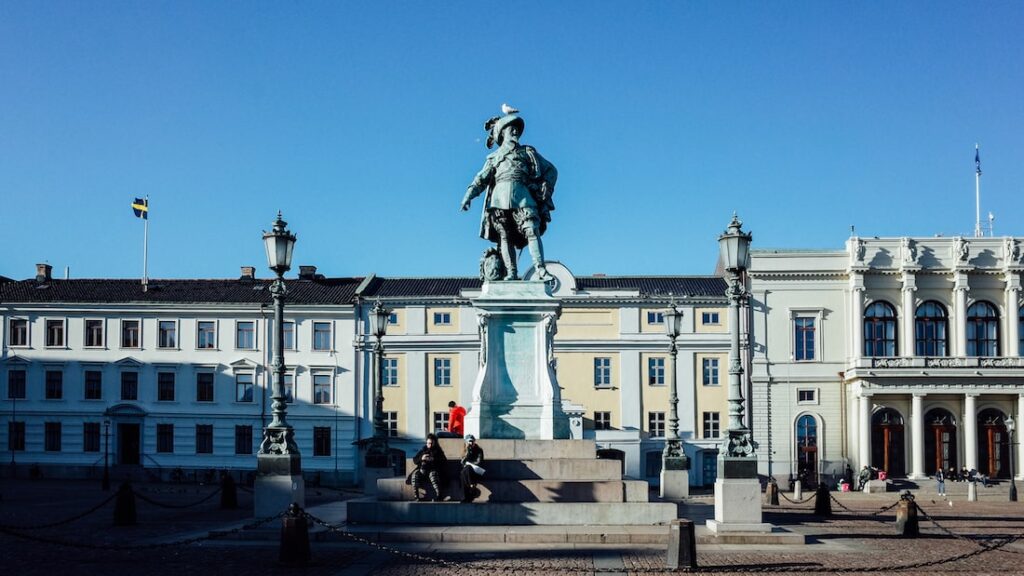
Gothenburg is a popular destination all year long. There are plenty of things to do in Gothenburg, no matter what time of the year you visit it. Of course, the summer days are long and the weather nicer, but this doesn’t mean you can’t enjoy the city during the winter or a rainy day. There are plenty of museums and indoor activities to keep you occupied any time of the year.
So, in this section, you’ll find the best things to do in Gothenburg, Sweden.
Take a Fika break

City breaks are ideal for getting a glimpse into local life. Therefore, I’ll start the list of things to do in Gothenburg with something very local: a Fika break.
Fika in Swedish means something like “pausing the day to enjoy a coffee break with friends.” And while it might sound familiar to you, I can assure you that for the Gothenburgers, it’s important and part of their routine. In Gothenburg, you’ll find some of the most atmospheric Scandinavian cafes, and delicious sweets always accompany the coffee. Especially popular are the cinnamon buns -and in the food section, I’ll share where you can find the biggest ones you ever saw.
Fika is more than a ritual: for the locals is some sort of art and a state of mind. The word’s origin probably derives from Kafi, the word for coffee. Just invert its syllables, and you get fika. So, why not start your Gothenburg city break by immersing straight ahead into one of the most local things? Order a coffee and something sweet, and slow down.
There are loads of cafes to enjoy a fika break (you’ll read more in the following sections). However, if you’d like to learn how to do it properly, there’s a tour with a local you can join. Your guide will explain the art of fika, take you to some cafes, and offer you a tour of the city. You can check the fika tour here.
Don’t miss the Gothenburg Museum of Art
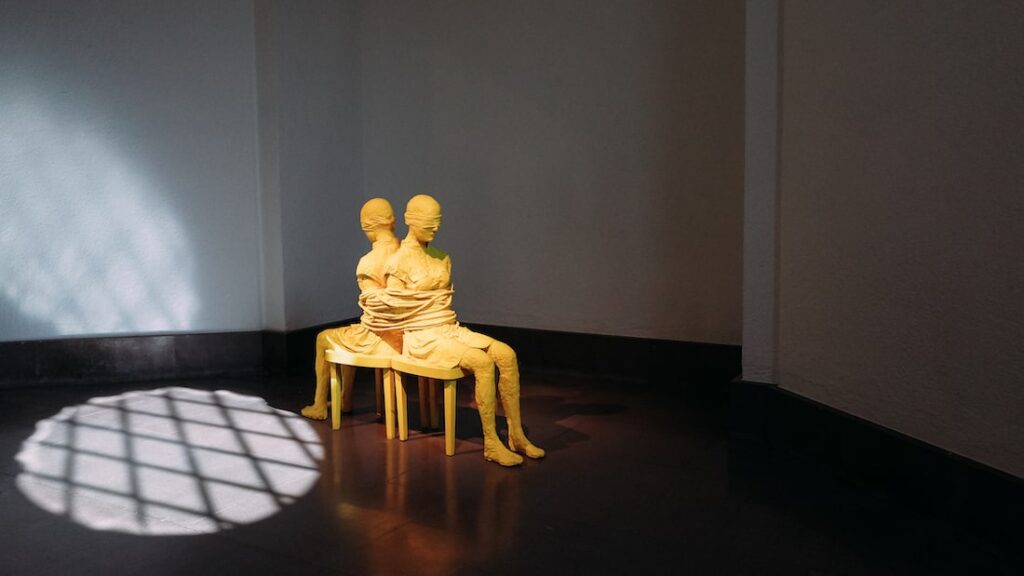
Gothenburg is home to plenty of fascinating museums. If you only have time to see one museum in Gothenburg, this should be the Museum of Art. It is assumed as one of the best museums in Scandinavia, and there’s a reason for that. It hosts many pieces of art, from internationally renowned artists but -most importantly- from Scandinavian ones. The latter is a reason by itself to visit the museum: you’ll discover fascinating artists that you never heard of before.
The museum has six floors, and each is dedicated to different eras. In my opinion, it is one of the best things to see in Gothenburg, and I wrote a separate article about it. You can read my guide to the Gothenburg Museum of Art here, and you can also read about Barbro Östlihn, an artist I discovered in the museum. If you’re an art lover, you can’t miss this museum.
Pro tip: There’s also a guided museum tour, where you’ll learn everything about the works of art. You can prebook the museum tour here.
Other museums in Gothenburg
There’s not enough time to see every museum on a Gothenburg city break. However, if you’re not that much into art, you can pick one of the following museums:
Volvo Museum. Did you know that Volvo, the iconic car company, comes from Gothenburg? There’s even a museum featuring cars and all kinds of info about Volvo. You can learn more about the Volvo Museum here.
Universeum. That’s one of the most important places in the city. Universeum is the science center of Sweden and a place for education. It has numerous halls and exhibitions, and the most impressive is an indoor (!) rainforest. Learn more about the Universeum.
Explore Haga

Haga is Gothenburg’s sweetest neighborhood. It’s the most laid-back hood in town, and people come here to relax and have a cup of coffee (fika, anyone?). You can find some 19th-century atmosphere in Haga, and that’s not just because of the cafes. The area is full of beautiful wooden houses.
No visit to Gothenburg is complete without a stop at Haga. Established in the 17th century by Queen Christina, Haga was for years a working-class district. Although it feels gentrified nowadays, it still has lots of charm, and it’s one of the nicest walking areas in the city. Apart from the charming atmosphere, you’ll discover local shops (textiles, design, souvenirs, etc.).
If you’d like to learn more about Haga, you can book a small group tour and have a local narrate stories from the district’s past. You can book the Haga tour here.
See Gothenburg from Skansen Kronan

Skansen Kronan is the small fortress that you’ll see in Haga. You’ll have to climb dozens of steps to reach it, but the view from the top is magnificent. You can see a fantastic view of the city, and on a clear day, you can also see the archipelago. The Skansen Kronan has been in use since 1698, and its purpose was to protect the (back then) young city from a Danish invasion.
To get an idea of how Gothenburg grew throughout the centuries, Skansen Kronan was once upon a time on the city’s outskirts. Nowadays, though, you can even call its location downtown.
Gothenburg city fact: Gothenburg was founded in 1621. It’s “just” 400 years old.
Take advantage of the Gothenburg hop-on-hop-off bus
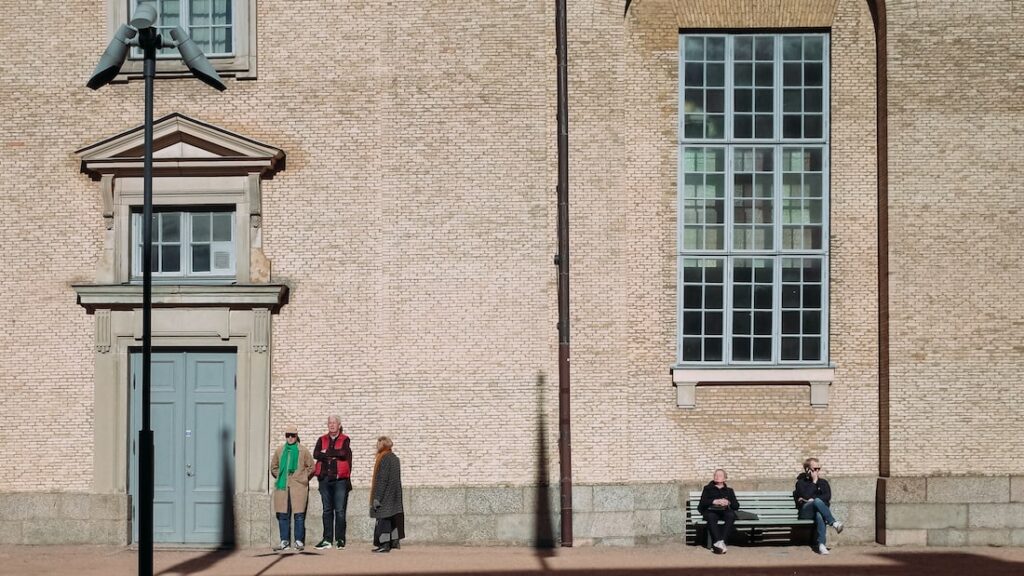
A hop-on-hop-off bus might sound ultra-touristy to some. However, the one running in Gothenburg passes several places of interest, and it’s a good alternative if you enjoy flexibility and freedom of choice. You can buy a 24-hour ticket and embark and disembark at every station.
For people on a Göteborg city break, it’s one of the easiest ways to explore the city. The 24-hour ticket costs currently 24 euros, and you can learn more about the hop-on-hop-off bus here.
Enjoy an hour with the Land & Water Amphibious bus
That’s one of the most original and fun things to do in Gothenburg. If the hop-on-off-bus is nothing for you, there’s a great alternative: an amphibious bus. This is a 10-ton bus transforming into a boat and splashing in the water! The tour lasts one hour, it costs 30 euros, and here’s what to expect.
You’ll start from the Stora Teatern in downtown Gothenburg, and from there, you’ll see the statue of Poseidon, the famous Avenyn, the Liseberg amusement park, and a bunch of other attractions. The fun part, though, starts when the surface changes and the bus has to get wet. That’s when the bus transforms into a boat and enters the river. All of a sudden, you’ll be sailing on the river and have beautiful city views.
The activity is safe and fun. A tour guide will be on board, sharing information about the city. You can book a place on the amphibious bus here.
Stroll around the Garden Society

The Garden Society is a fabulous park in downtown Gothenburg. It’s one of Europe’s best-kept 19th-century parks, and you’ll see -among other things- a Palm House dating back to 1878. During the summertime, you’ll see thousands of beautiful roses in the gardens, while the Palm House hosts many exotic plants.
Apart from being one of the best walks in downtown Gothenburg, you can also have a picnic with your friends (no alcohol, no dogs), and there’s also a restaurant within the Garden Society.
Feskekörka: the food-church

One of the odd things to see in Gothenburg is the Feskekörka. Don’t be fooled by its exterior: that’s not a church, even if it looks like one. The Feskekörka is an indoor fish market hosted in a building that resembles a Gothic church. It dates back to 1874 and is the best place to enjoy fresh fish. You can buy fish, but there’s also a high-quality restaurant inside the Feskekörka. On a sunny day, you can grab a portion of fish or seafood and sit by the river to enjoy your meal.
Enjoy Liseberg
Liseberg is almost a synonym for Gothenburg. The famous amusement park attracts millions of visitors annually and is loved by kids and adults. The hundred-year-old Liseberg has more than 30 different rides, and it also hosts dance halls, music venues, and restaurants. Liseberg has two entrances (Örgrytevägen and Getebergsled), one of the city’s greenest areas.
As you can imagine, you can easily spend an entire day there. Therefore, visit Liseberg and enjoy either the rides or simply a walk in one of the top 10 amusement parks in the world, according to Forbes.
A day out at the Gothenburg archipelago
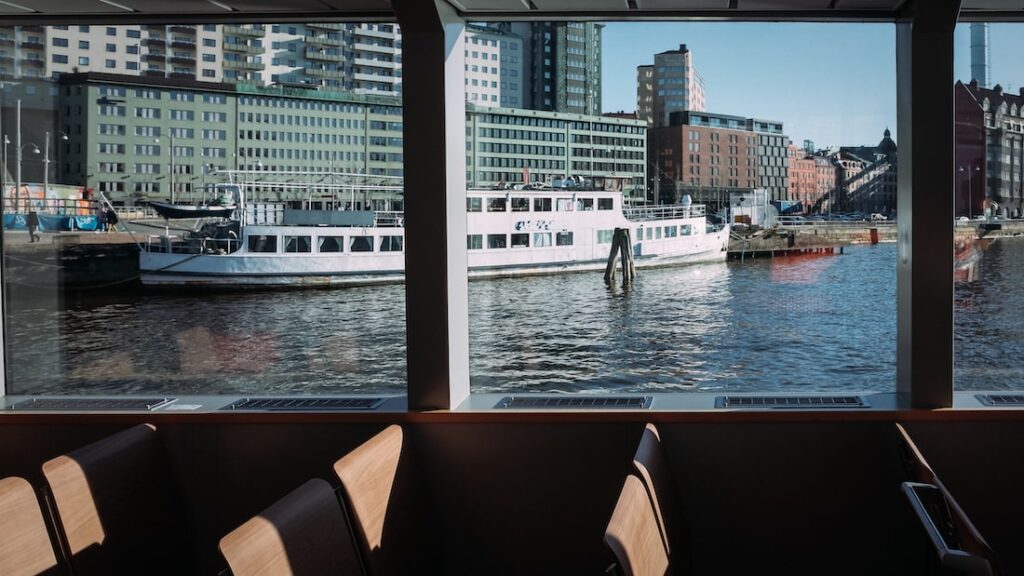
Enjoying a day out at the Gothenburg archipelago is probably one of the top things to do. However, since this is a full-day excursion, it’s better to do it if you have at least two full days in the city. Otherwise, you might miss pretty much everything mentioned above.
The Gothenburg archipelago features two subcomplexes of islands, the southern and the northern. They are equally beautiful, and you should see as much as possible. Apart from their geographic position, there’s also something more separating them. The Southern Islands are car-free, while the Northern Islands have more inhabitants, and you can even bring your own car.
Ferries to the Gothenburg archipelago depart from various places in town, and the biggest hubs are Stenpiren and Saltholmen. You can find a map with the routes to the archipelago here.
Where to stay in Gothenburg for a perfect city break

New hotels open up constantly in the city, and since Gothenburg is famous among interior design lovers, you can expect an eclectic mix of accommodations. However, not everything is about top-notch Scandinavian design. On the contrary, some of the city’s most charming hotels are old-fashioned.
Most of the hotels lie around the central train station. You’ll find plenty of four-star hotels (and some 5 stars, too) in this area, which is the city’s heart. Another excellent and relatively quieter area for your Gothenburg accommodation is close to Liseberg, the Museum of Contemporary Art, and the famous Avenyn Street. This is one of the most traditional areas of downtown Gothenburg, and while you’ll be a twenty-minute walk from the center, you will find lots of charm here.
Finally, as you read earlier on the best things to do in Gothenburg, Haga is probably the most beloved area for travelers. However, the charming neighborhood is preserved by its residents, and you won’t find any hotels in Haga.
Please keep in mind that prices depend on the season: most hotels will cost 50% less if you visit off-season. On the other hand, visiting Gothenburg during the summertime means that everything will be significantly pricier.
So, below, you’ll find my handpicked selection of hotels for your Gothenburg city break.
The best hotels in Gothenburg around the train station (city center)
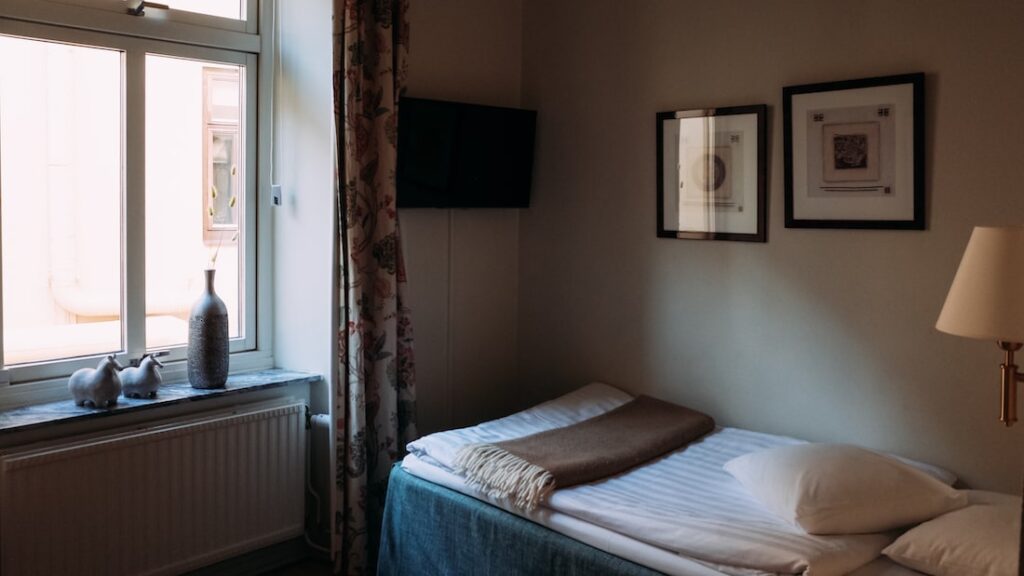
Hotel Royal. That’s hands down one of the most charming hotels in Sweden. I chose Hotel Royal for my Gothenburg city break, so I added it first to this list. Located just a 5-minute walk from Gothenburg Central Train Station, Hotel Royal is an exceptional hotel. Housed in a building dating back to 1852, the hotel has old-fashioned rooms with a charming atmosphere. Moreover, there’s complimentary tea, coffee, and sweets all day long. Book your room at Hotel Royal here.
*Bonus: I wrote an extensive review about the Hotel Royal Gothenburg here.
Dorsia Hotel. That’s one more excellent option for your stay at Gothenburg. Dorsia Hotel is located close to the Central Station and just steps away from the Kungsportsplatsen Tram Stop (where the airport bus also stops). Apart from the luxurious decor and the comfy beds, there’s also a restaurant at Dorsia serving high-quality French cuisine. Book your room at Dorsia Hotel.
Radisson Blu Göteborg. Finally, for lovers of timeless Scandinavian design and luxury, you also have the opportunity to stay at a Radisson. The Radisson Blu Hotel is just a few meters away from Central Station (and close to Hotel Royal), and apart from the beautiful rooms, it also offers a spa and yoga studio. Access to the gym is free, and some rooms have a Nespresso coffee machine. Last but not least, you’ll find the elegant Atrium restaurant on the ground floor. Book your room at Radisson Blu.
The best hotels in Gothenburg close to Liseberg
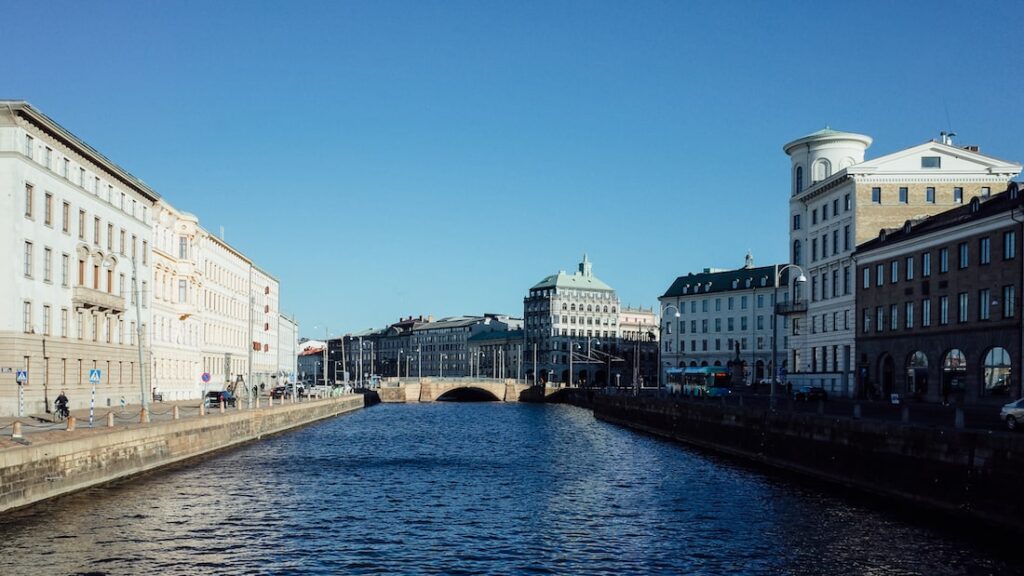
Gothia Towers. Located straight opposite the famous Liseberg amusement park and featuring a 23rd-floor bar, Gothia Towers is one of the top Gothenburg accommodations. The rooms are spacious and clean, and you’ll enjoy breathtaking views. Book your room at Gothia Towers.
Hotel Lorensberg. That’s a great family run with cozy rooms and many original paintings on the walls. The hotel also has a sauna and a beautiful garden. If you’re an art lover, that’s the place to stay. See more about Hotel Lorensberg.
Hotell Onyxen. This hotel, situated in a 19th-century building, offers free WiFi and complimentary tea and coffee all day. Book your room at Hotell Onyxen.
Elite Park Avenue Hotel. This hotel offers typical Swedish rooms on Gothenburg’s main street, Avenyn. It also has a sauna and a popular restaurant. Book your room at Elite Park Avenue Hotel.
The best hotel close to Haga
Göteborgs Mini Hotel. Located in the nearby cozy neighborhood of Majorna, the Mini Hotel is the closest hotel to Haga you can stay right now. It’s a relatively simple hotel, and the rooms don’t have an en-suite bathroom. However, the Mini Hotel is significantly cheaper than other downtown hotels, and if you are after an affordable option, it’s a real bargain. See Göteborgs Mini Hotel.
Please use the interactive map below for all other accommodation options in Gothenburg, Sweden.
How to get around Gothenburg
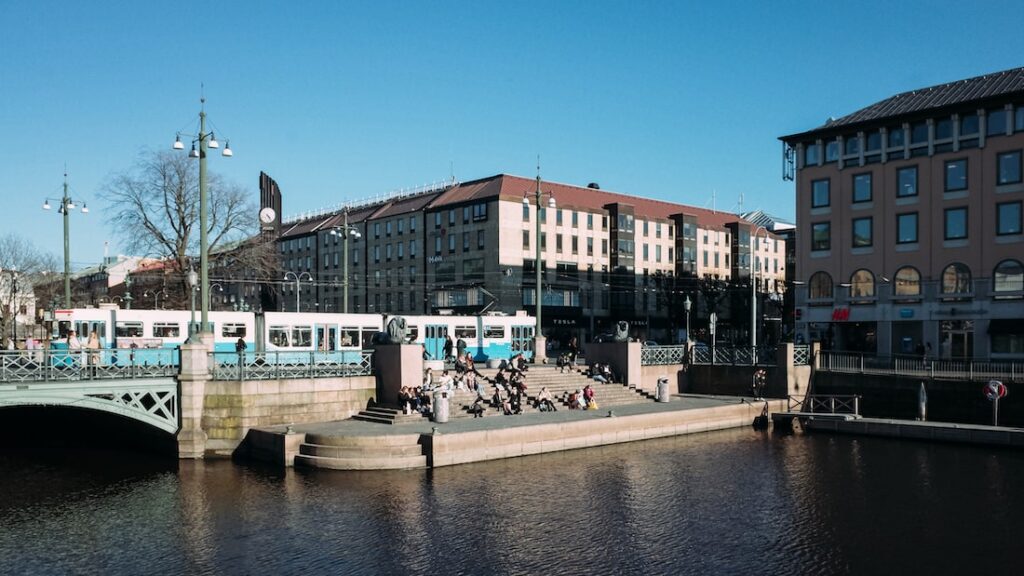
Gothenburg is a compact city, and you can walk its downtown area in one day. There’s no subway in Gothenburg, but you have two excellent ways to explore everything that Gothenburg has to offer.
Gothenburg by tram
The easiest way around the town is by using the trams. The tram lines are busy throughout the day, and they’ll bring you everywhere in the city. The blue and white trams of Gothenburg are (as you might expect in Scandinavia) very accurate. You can find their routes here, and the ticket costs 35 SEK (approx. 3,5 euros)
Of course, since you’ll be on a Gothenburg city break, you can also consider buying a multi-day ticket for public transport. You won’t probably need anything more than an A-Zone Ticket (there are also AB and ABC tickets). The A-Zone Gothenburg ticket currently costs 115 SEK for one day (approx. 11,5 euros), and for three days (72 hours), it costs 230 SEK (approximately 23 euros).
Gothenburg by bike
Gothenburg is a paradise for cycling. Featuring hundreds of kilometers of bikeways, the city is a dream to cycle around. You can explore downtown Gothenburg by bike, but you can also cycle outside of town. If you’re into cycling, don’t miss the chance to rent a bike and explore the city and -why not- even the region.
There are multiple bike rentals around the town, but you can use a bike-sharing app if you don’t want to deal with expensive rentals. The best option is NextBike, operated under Styr & Ställ in Sweden. You can pick up a bike from any of the stations around the city and pay as you go. The charge is 20 SEK every thirty minutes (2 euros), but you can’t spend more than 300 SEK per day (30 euros). Therefore, even if you keep the bike for 10 or even 15 hours within the same day, you won’t pay more than 30 euros.
Last but not least, you can leave your bike in the city center wherever you want; therefore, you don’t have to bring it back to the station where you picked it up. However, leaving a bike outside the city center is costly and comes with a surcharge.
Where to eat in Gothenburg

It’s not a surprise that there are plenty of restaurants in Gothenburg. After all, that’s Sweden’s second-biggest city, and your options are countless, spanning between local joints and fancy restaurants. Traditional Swedish cuisine is delicious, and you can also taste various fish dishes. In the shortlist below, you’ll see the places I enjoyed eating in Gothenburg.
Every link in this section will forward you to the restaurant’s location on Google Maps. Therefore, you can bookmark these places and create your Gothenburg food itinerary.
Fiskbar 17. This tiny restaurant doesn’t accept reservations, but it has some of the most delicious fish you can taste in town. Located at the famous Magasinsgatan, Fiskbar 17 is a joint that serves street food like fish. I enjoyed eating here twice. Ask for the day’s fish -together with a glass of wine, it will cost approx. 35 euros. See Fiskbar 17 on the map.
Atrium (at Radisson). The Radisson Blu Hotel hosts one of the nicest restaurants in Gothenburg. The interior is spacious, and the food is fantastic. The prices are steep, but the dinner is a culinary experience. A starter, a main course, and a dessert will cost approx. 60 euros together with a drink. See Atrium on the map.
Sjöbaren Haga. On the main street of the beautiful hood, called Haga Nygata, Sjöbaren is the place to eat fish and seafood on this side of town. The prices are between Fiskbar and Atrium, but the food is equally delicious. See Sjöbaren.
2112. That’s the place to eat burgers in downtown Gothenburg. 2112 has a variety of burgers and offers vegan and vegetarian options too. A burger and a drink will cost you about 25-30 euros. See 2112.
Da Matteo. That’s one of the most famous coffee places in Gothenburg. It has multiple locations around the city, but the nicest is the one at Victoriapassagen. See Da Matteo here.
Kafe Magasinet. Look no further if you’re searching for the most Instagrammable cafe in Gothenburg. Kafe Magasinet is more than a cafe: it’ll remind you of an old but stylish warehouse; it has lots of plants and serves fantastic coffee and snacks. Hands down one of the best places in the city. See Kafe Magasinet on the map.
Cafe Husaren. Last but not least, Cafe Husaren is a typical fika place. That’s also where you’ll find the biggest cinnamon buns in the city. Don’t miss it, especially on a sunny day: it’ll have tables and chairs on the street, and you can observe Haga’s life to its fullest. See Cafe Husaren.
How to budget for a relaxed Gothenburg city break
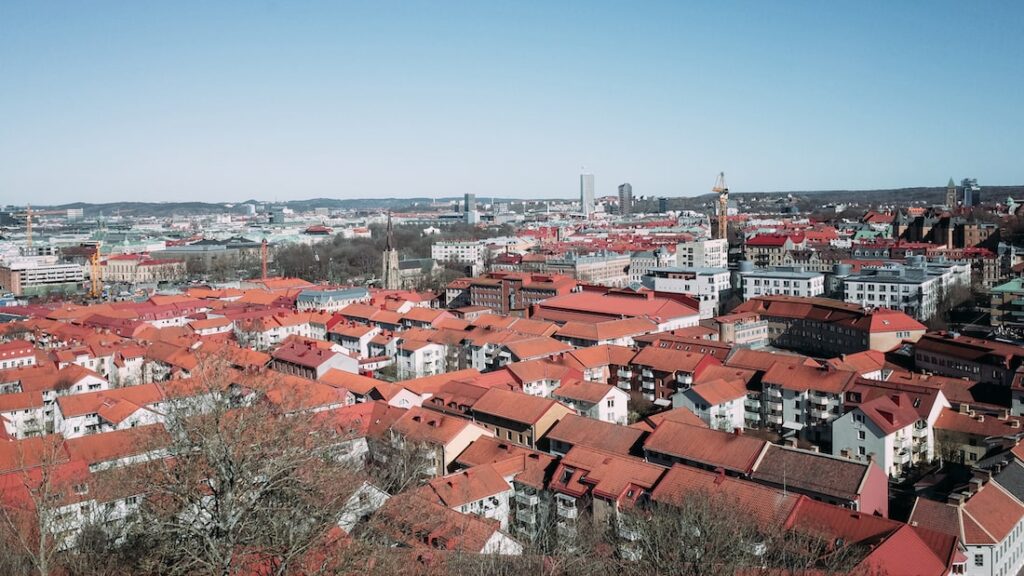
It’s not a surprise that Gothenburg is not the cheapest city break destination in Europe. After all, Scandinavia is Europe’s most expensive region. However, compared to other neighboring cities, Gothenburg feels slightly cheaper. So, let’s break down the costs for a wonderful Gothenburg city break.
Flights. Everything goes here, and it mainly depends on how early you book. You can find very cheap flights if you book in advance: it’s actually not uncommon to find EasyJet or Ryanair itineraries for 50 euros return. So, book your flights in advance to secure a fair price.
Hotels. The hotels in Scandinavia are beautiful but also pricey. Your accommodation (together with the food) will be your main expense during your Gothenburg long weekend or city break. Staying in downtown Gothenburg is, of course, a must if you want to see as much as possible. For a double room in the city center, expect to pay anything from 120 euros and up. Even in this price range, the hotels are just a few. The majority of hotels are much pricier.
Food. The food is relatively expensive in Gothenburg. Even if you go for a fast food option, you won’t be able to get food at a very low price. On the other hand, eating in a restaurant -a main dish and a drink- will cost you approximately 40-45 euros. Obviously, if you choose to have a starter and/or a dessert, paying 60-70 euros shouldn’t surprise you.
Other expenses. Museum entrances, public transportation tickets, or an excursion to the Gothenburg archipelago won’t be unaffordable. Therefore, you should calculate European capital standards for your other expenses.
So, how much should I calculate per day for my Gothenburg city break?
Long story short, here’s what I’d calculate on a daily basis for an off-season city break to Gothenburg (and what I also paid).
A double room that costs 120 euros means 60 euros per person per day for two people. For a light lunch and a dinner, it’s logical to spend 60 euros per person. For all other expenses, you should calculate approximately 50 euros per day. This includes a bottle of water, a museum ticket, a rented bike for an hour, a coffee, and a random Swedish souvenir.
Therefore, a solo traveler to Gothenburg should calculate approximately 180-200 euros per day, including accommodation, food, tickets, etc. Subsequently, if you are two people traveling and sharing a room, it’ll be slightly cheaper: calculate approximately 140 euros per person per day.
Finally, if you travel during the high season, I’d say that calculating 50 euros more per day per person sounds reasonable.
Bonus Gothenburg tip: how to quickly convert Swedish krona (SEK) to USD or EUR.
Sweden’s currency is the Swedish krona (SEK). The following tip helped me convert the prices quickly. However, this is just an approximation, and it’s not totally accurate. But if you don’t want to constantly have a calculator in hand, that’s the quickest way.
So here’s the conversation tip: whenever you see a price in SEK, all you have to do is add a decimal point before the last digit. That said, if something costs, for example, 60 SEK will be close to 6.0 euros or 6.0 USD. Of course, that’s an approximation. The exact cost will be 5,81 EUR or 6,43 USD for the record. But at least you won’t need a calculator every time you see a price.
When it’s the best time to have a city break in Gothenburg?

Scandinavian winters tend to be cold and snowy, while in summertime, the days are long, and the weather is usually warm. On the other hand, visiting Gothenburg in winter or early spring will be significantly cheaper than in summer.
Apart from the budget issue, there are also great timeslots throughout the year. For example, Gothenburg hosts several festivals, so you can check if they fit your schedule. Attending a festival would be a great addition to your city break.
Some festival and their dates to keep in mind:
- The International Film Festival. It usually takes place in late January.
- Summerburst music Festival. It takes place in June at Ullevi Stadium.
Long story short: if Scandinavian prices scare you, visit Gothenburg off-season. On the other hand, if you can afford the cost, visit during the summer and enjoy the long, warm days.
Gothenburg city break: final thoughts

Gothenburg is one of the liveliest and most beautiful cities in Scandinavia. After being overlooked for years, the city started receiving the attention it deserves. There are plenty of things to see and enjoy in Gothenburg, and immersing in the local lifestyle will give you peace of mind. Add the delicious food and the proximity to the sea, and you’ll have a perfect getaway. Spending three or four days in Gothenburg will refill your batteries and show you an aspect of local life.
Enjoy Gothenburg, and don’t forget to enjoy the fika breaks.
More about Gothenburg: My Göteborg travelogue, The Göteborg Museum of Art
Pin it for later
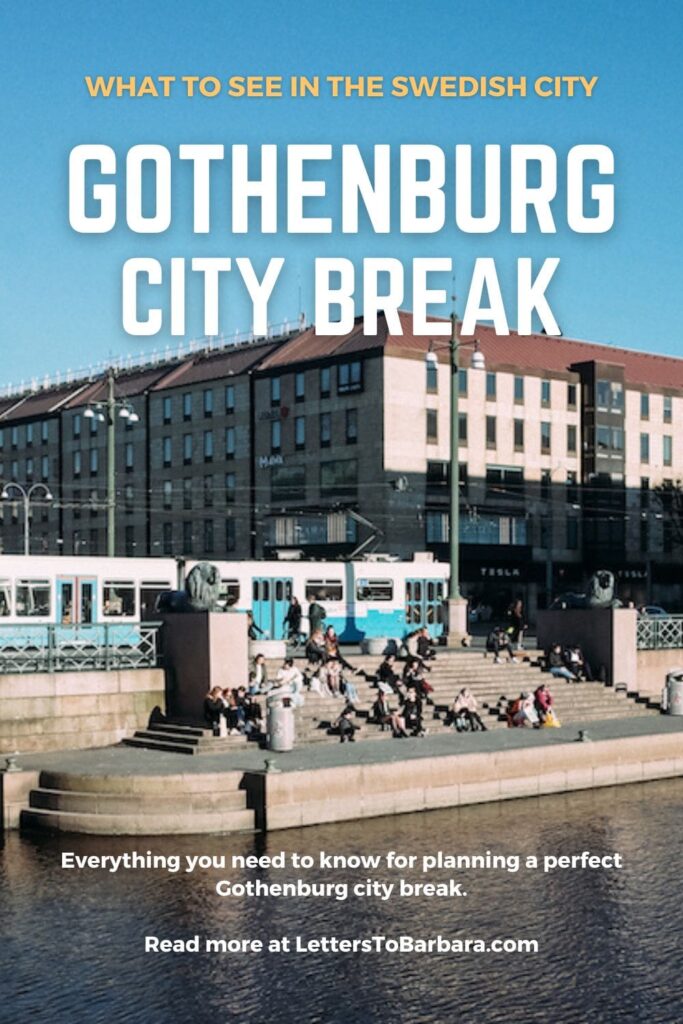
Sharing is caring. Share this Gothenburg travel guide with your friends.
Last Updated on June 14, 2024 by George Pavlopoulos

